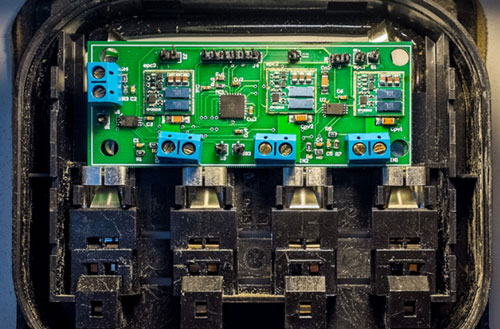| Jun 21, 2016 |
Novel device to boost power output from solar panels
|
|
(Nanowerk News) While recent advancements in solar cell technologies have significantly improved their sunlight-to-energy conversion efficiencies, without continued advancements in the actual panel technology, photovoltaic (PV) systems will never realize their maximum potential.
|
|
This is because technological limitations prevent solar panels – which amplify and boost the electric current generated by multiple solar cells – from supplying all the electricity they generate to the electric grid. However, a team of researchers from the Masdar Institute may have discovered a way to overcome these technological limitations in the most popular PV connection system through a novel, low-cost and easy-to-install device that could significantly increase the amount of power generated by the system.
|
|
“The problem occurs in series-connected solar panels (which is one of the most common ways of connecting solar panels for distributed PV systems), when solar modules are experiencing varying levels of irradiation or temperature. This can result from sporadic clouds, dust accumulation on the PV panels, or uneven air ventilation. In these instances, the current generated by each module is different,” explained Masdar Institute Research Engineer Omair Khan.
|
|
“The low-performing solar modules affect the energy output of the entire string of solar panels, as the maximum power output is governed by the lowest current in the system. This means that if one solar module is shaded and thus generating a low current, and is connected in series to several good, high-performing modules, then the high-performing modules cannot operate at higher currents,” he added.
|
 |
| Associate Professor Dr. Weidong Xiao and Research Engineer Omair Khan developed a gallium nitride-based device that fits inside a photovoltaic panel and can track each of the independently produced solar currents generated by a solar panel.
|
|
The device developed by Khan and Masdar Institute Associate Professor of Electrical Engineering and Computer Science Dr. Weidong Xiao aims to optimize the power output of the series-connected solar panels. Series-connection is how the majority of PV panels are connected in a PV system and to electrical grids, including small-scale rooftop PVs and large-scale solar power plants.
|
|
Series-connected solar panels direct the electrical currents produced by each submodule (usually three submodules form a solar panel) through the group, or “string”, of connected solar panels to the string’s centralized converter. The drawback of series-connected solar panels is that each panel needs to share the same electric current, which is set by the submodule with the lowest current.
|
|
Khan and Dr. Xiao think they discovered a way to get around this “lowest current” limitation that series-connected solar panels face, through their device – called a “submodule integrated converter” – which tracks and feeds each of the three independently produced electrical currents for one solar module directly into the centralized converter, thus boosting the PV system’s overall power output, especially in the case of a current mismatch.
|
|
It does this by capitalizing on the key properties of gallium nitride, which is the material used to make the converter’s switches. Gallium nitride’s high electrical conductivity is able to convert 99% of the power produced by each submodule into electricity for the centralized converter and enables the device to be made small enough to fit into the existing junction box on the back of each solar panel. Thus, the device can be easily installed into existing solar panels without needing to retrofit or re-build conventional solar panel systems.
|
|
“By employing a dedicated converter to independently perform maximum power point tracking on each submodule, rather than the string of modules as a whole, means that the operating point of each submodule has no effect on the rest of the submodules in the system. Each converter extracts the maximum power possible from each submodule, thus maximizing the PV system’s energy-efficiency,” explained Khan.
|
|
“Through this novel device, we are able to get more electricity out of conventional solar panels using a method that is easily scalable,” said Dr. Xiao.
|
|
The researchers plan to optimize the product and develop a ready-to-install version that is capable of withstanding the UAE’s harsh weather.
|
|
Khan and Dr. Xiao co-authored three journal papers on this research this year including two in the IEEE Transactions on Industrial Electronics and one in IEEE Transactions on Sustainable Energy.
|

